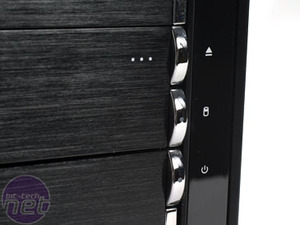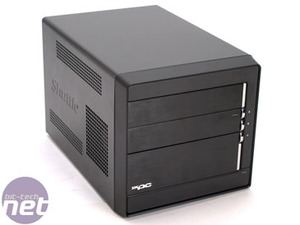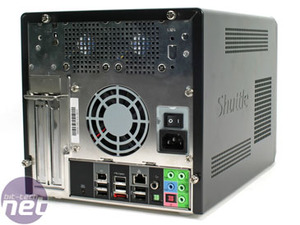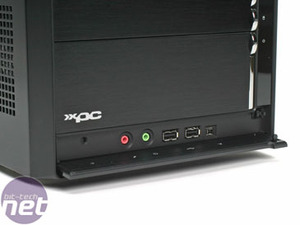The Shuttle SD37P2 combines the most popular Small Form Factor (SFF) maker's XPC line with the most popular current generation processor: Core 2. Using an Intel 975X chipset, the SD37P2 provides oodles of power in a tiny space, using Shuttles renowned skill in engineering small things efficiently for people. It provides space for up to three hard drives, including support for RAID as well as all the mod cons like eSATA, eight USB 2.0 ports, Firewire and HD Audio. With all this cutting edge technology in such a small box, we found out if Shuttle continued to make another standard-setting SFF product that's well-worth spending your money on.



 Shuttle does the usual and expertly kits out its XPC with all the additional extras you could possibly require. Included are especially short floppy and SATA cables and a tightly rounded IDE cable that take up the absolute minimum of extra space within the case. You get the specially designed and highly efficient ICE heatsink and fan unit, as well as all the screws and thumbscrews you could possibly need.
Shuttle does the usual and expertly kits out its XPC with all the additional extras you could possibly require. Included are especially short floppy and SATA cables and a tightly rounded IDE cable that take up the absolute minimum of extra space within the case. You get the specially designed and highly efficient ICE heatsink and fan unit, as well as all the screws and thumbscrews you could possibly need.
The case itself is a matt black aluminium with square ventilation holes on both sides surrounding an embossed Shuttle logo. The larger holes are there so that the ICE unit can breathe and pass through air with minimal effect to the rest of the units internal temperature. The front has a glossy black plastic surrounding a "stealthed" 3.5" and 5.25" external bay. The black looks great and the stealthed drives offer a far more pleasing attire to the eye despite the black bar on the right disturbing the even look, it still comes across sleek and professional.
Down the right hand side there is the 5.25" DVD eject button and the power button, Shuttle does not include a reset button here unfortunately; instead, it's under the flap at the bottom and requires a pen to press it. The middle "button" is merely styled to continue the theme but is merely the hard disk activity LED. This is a little confusing, as you expect it to be the reset button. Because the reset button requires a pen to press it in, you find yourself holding the power button for a few seconds to kill the machine, before turning it back on again. This whole process is detrimental to the life of your components who prefer to be left on with a constant electrical flow, rather than to go through continual on/off cycles.
The bottom pops open to reveal front headphone and microphone ports as well as two USB 2.0 ports and a single mini 4-pin Firewire port. Considering this case is most likely to be on a desk this is a wonderful convenience, to just pop your mouse and keyboard into the front USB ports, or to easily plug in some headphones and microphone for Skype. Its size means that it is also great for LANs.
Using the front audio ports was, however, a whole different kettle of fish. The headphone socket suffers from a lot of low level noise that the rear ports don't have. Sadly, the interference is at such a level that can cause major annoyances when playing games or watching DVDs!
Shuttle SD37P2 Overview
- Support for all Intel LGA775 processors (533, 800 and 1066MHz front side bus) including Pentium 4, Pentium D, Pentium Extreme Edition, Core 2 Duo, Core 2 Quad and Core 2 Extreme processors;
- Intel 975X chipset and ICH7R southbridge with RAID 0, 1, 0+1 (10) and 5 support;
- Support for up to 8GB of DDR2-533 and DDR2-667 memory, with ECC memory support;
- Two PCI-Express x8 slots with ATI Crossfire support (and unofficial NVIDIA SLI support);
- Realtek ALC882 High Definition audio codec with 8 channel sound support, S/PDIF in and out and front headphone and microphone ports;
- Broadcom PCI-Express Gigabit Ethernet controller;
- Four native SATA 3Gbps ports: three internal SATA ports and one eSATA;
- Two IEEE1394a Firewire ports via VIA's VT6307 Firewire controller;
- Eight USB 2.0 ports, six rear and two on the front;
- 400W PSU with active PFC;
- "P2" chassis design including Shuttle Integrated Cooling Engine (ICE), Smart Fan, Stealthed Drives and built in cable management.


Box Contents:
- Shuttle XPC User Guide;
- Shuttle XPC CD Driver (32-bit & 64-bit versions of Windows XP);
- Shuttle Extras CD;
- One IDE cable;
- One single ended short floppy cable;
- One Power cord;
- Two SATA cables;
- Screws and Thumbscrew replacements;
- Thermal compound.


The case itself is a matt black aluminium with square ventilation holes on both sides surrounding an embossed Shuttle logo. The larger holes are there so that the ICE unit can breathe and pass through air with minimal effect to the rest of the units internal temperature. The front has a glossy black plastic surrounding a "stealthed" 3.5" and 5.25" external bay. The black looks great and the stealthed drives offer a far more pleasing attire to the eye despite the black bar on the right disturbing the even look, it still comes across sleek and professional.
Down the right hand side there is the 5.25" DVD eject button and the power button, Shuttle does not include a reset button here unfortunately; instead, it's under the flap at the bottom and requires a pen to press it. The middle "button" is merely styled to continue the theme but is merely the hard disk activity LED. This is a little confusing, as you expect it to be the reset button. Because the reset button requires a pen to press it in, you find yourself holding the power button for a few seconds to kill the machine, before turning it back on again. This whole process is detrimental to the life of your components who prefer to be left on with a constant electrical flow, rather than to go through continual on/off cycles.
The bottom pops open to reveal front headphone and microphone ports as well as two USB 2.0 ports and a single mini 4-pin Firewire port. Considering this case is most likely to be on a desk this is a wonderful convenience, to just pop your mouse and keyboard into the front USB ports, or to easily plug in some headphones and microphone for Skype. Its size means that it is also great for LANs.
Using the front audio ports was, however, a whole different kettle of fish. The headphone socket suffers from a lot of low level noise that the rear ports don't have. Sadly, the interference is at such a level that can cause major annoyances when playing games or watching DVDs!

MSI MPG Velox 100R Chassis Review
October 14 2021 | 15:04









Want to comment? Please log in.